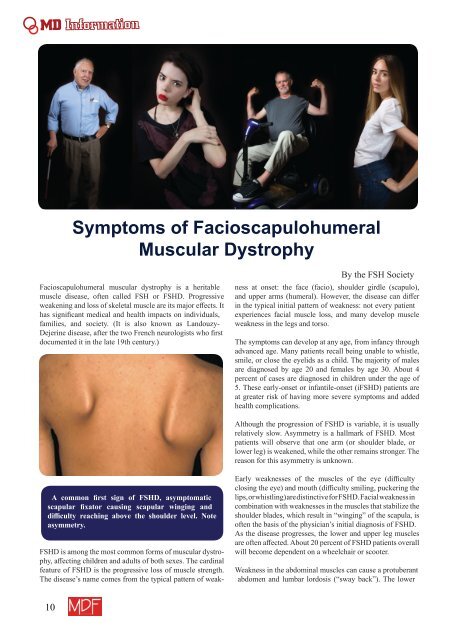MDF Magazine Newsletter Issue 59 August 2019
Create successful ePaper yourself
Turn your PDF publications into a flip-book with our unique Google optimized e-Paper software.
MD<br />
Symptoms of Facioscapulohumeral<br />
Muscular Dystrophy<br />
Facioscapulohumeral muscular dystrophy is a heritable<br />
muscle disease, often called FSH or FSHD. Progressive<br />
weakening and loss of skeletal muscle are its major effects. It<br />
has significant medical and health impacts on individuals,<br />
families, and society. (It is also known as Landouzy-<br />
Dejerine disease, after the two French neurologists who first<br />
documented it in the late 19th century.)<br />
By the FSH Society<br />
FSHD is among the most common forms of muscular dystrophy,<br />
affecting children and adults of both sexes. The cardinal<br />
feature of FSHD is the progressive loss of muscle strength.<br />
The disease’s name comes from the typical pattern of weakness<br />
at onset: the face (facio), shoulder girdle (scapulo),<br />
and upper arms (humeral). However, the disease can differ<br />
in the typical initial pattern of weakness: not every patient<br />
experiences facial muscle loss, and many develop muscle<br />
weakness in the legs and torso.<br />
The symptoms can develop at any age, from infancy through<br />
advanced age. Many patients recall being unable to whistle,<br />
smile, or close the eyelids as a child. The majority of males<br />
are diagnosed by age 20 and females by age 30. About 4<br />
percent of cases are diagnosed in children under the age of<br />
5. These early-onset or infantile-onset (iFSHD) patients are<br />
at greater risk of having more severe symptoms and added<br />
health complications.<br />
Although the progression of FSHD is variable, it is usually<br />
relatively slow. Asymmetry is a hallmark of FSHD. Most<br />
patients will observe that one arm (or shoulder blade, or<br />
lower leg) is weakened, while the other remains stronger. The<br />
reason for this asymmetry is unknown.<br />
A common first sign of FSHD, asymptomatic<br />
scapular fixator causing scapular winging and<br />
difficulty reaching above the shoulder level. Note<br />
asymmetry.<br />
Early weaknesses of the muscles of the eye (difficulty<br />
closing the eye) and mouth (difficulty smiling, puckering the<br />
lips, or whistling) are distinctive for FSHD. Facial weakness in<br />
combination with weaknesses in the muscles that stabilize the<br />
shoulder blades, which result in “winging” of the scapula, is<br />
often the basis of the physician’s initial diagnosis of FSHD.<br />
As the disease progresses, the lower and upper leg muscles<br />
are often affected. About 20 percent of FSHD patients overall<br />
will become dependent on a wheelchair or scooter.<br />
Weakness in the abdominal muscles can cause a protuberant<br />
abdomen and lumbar lordosis (“sway back”). The lower<br />
10


















